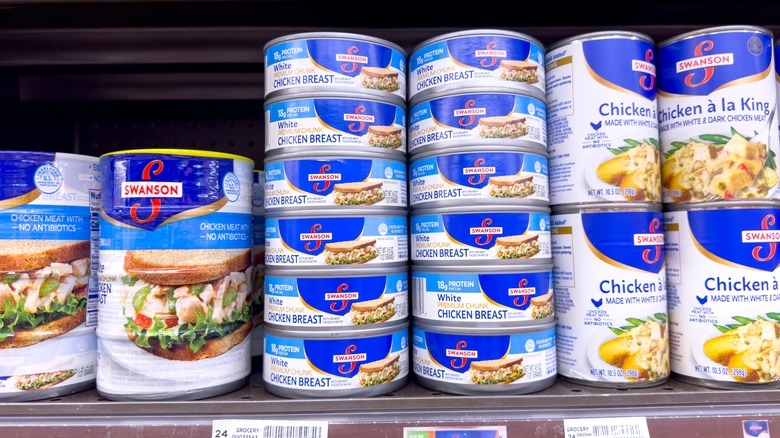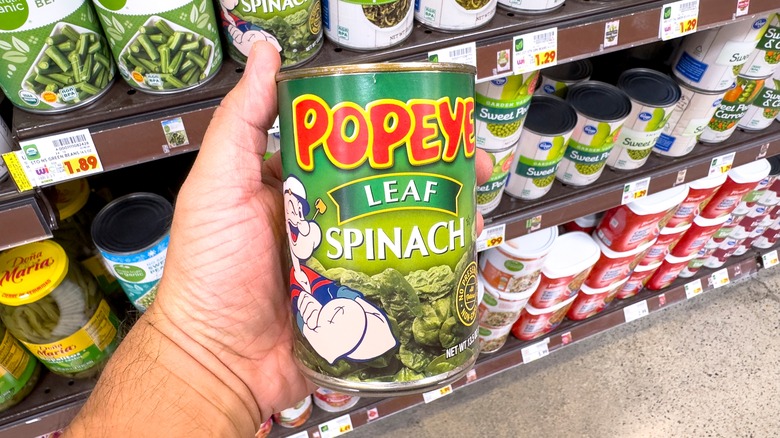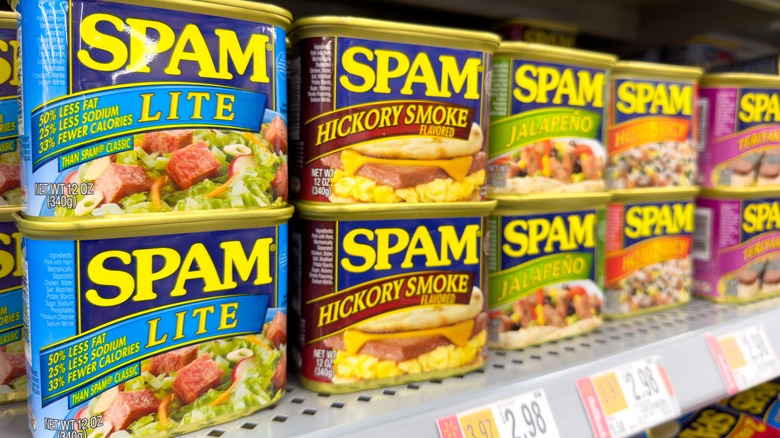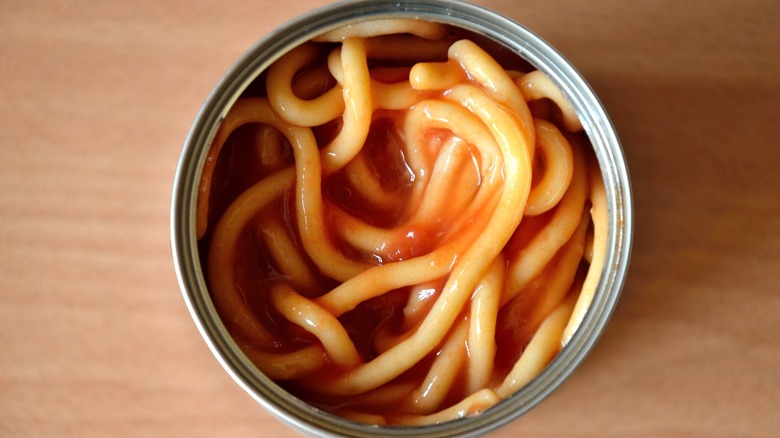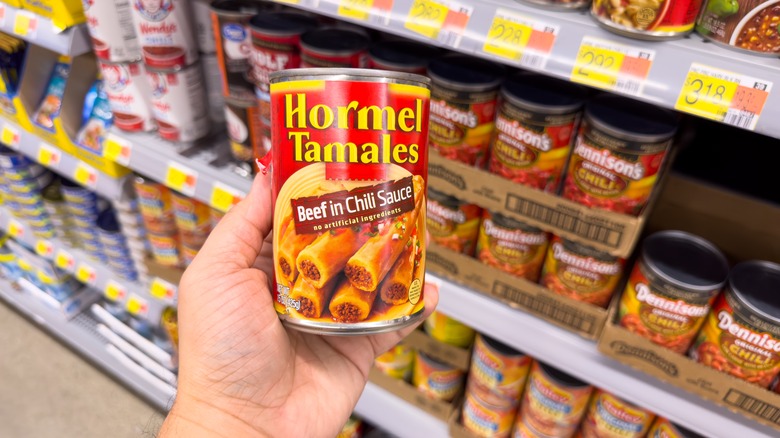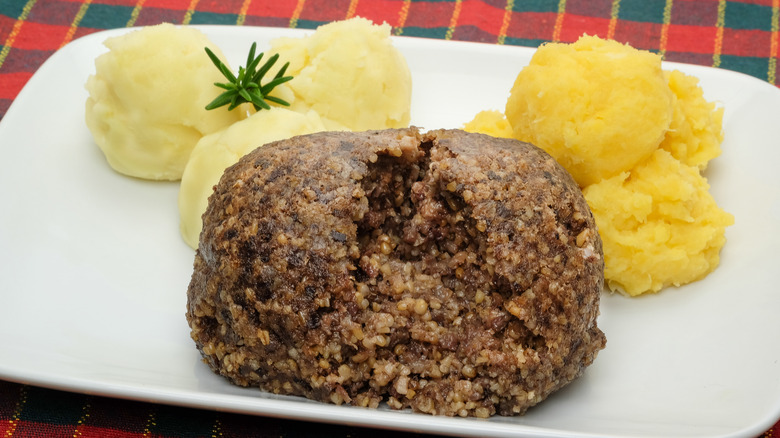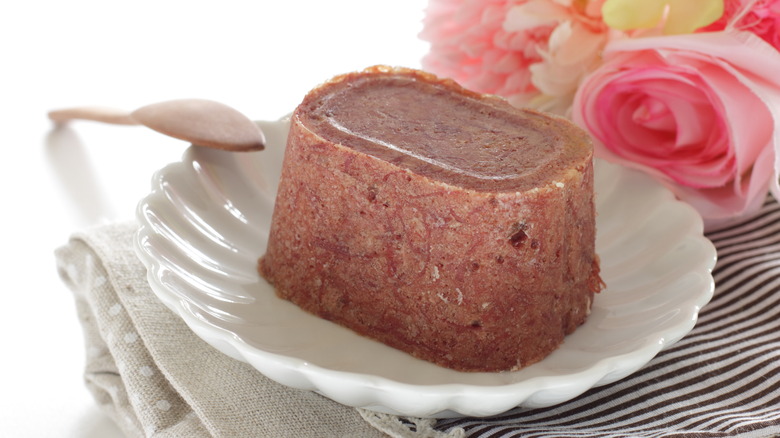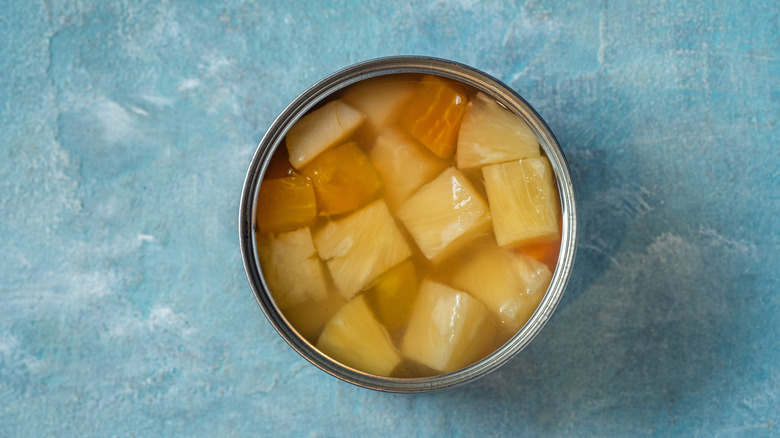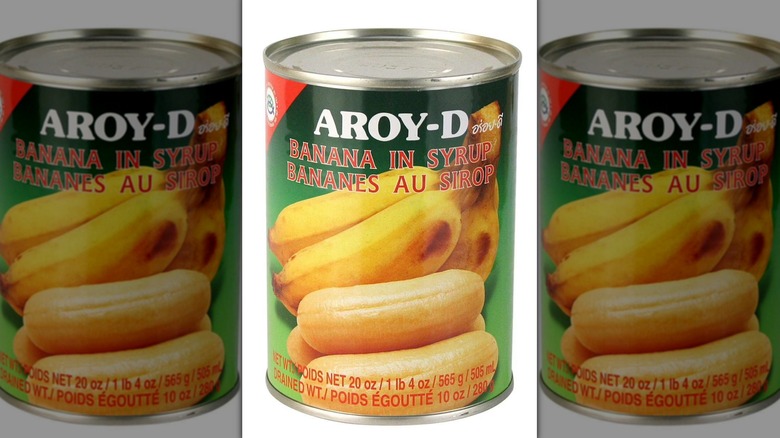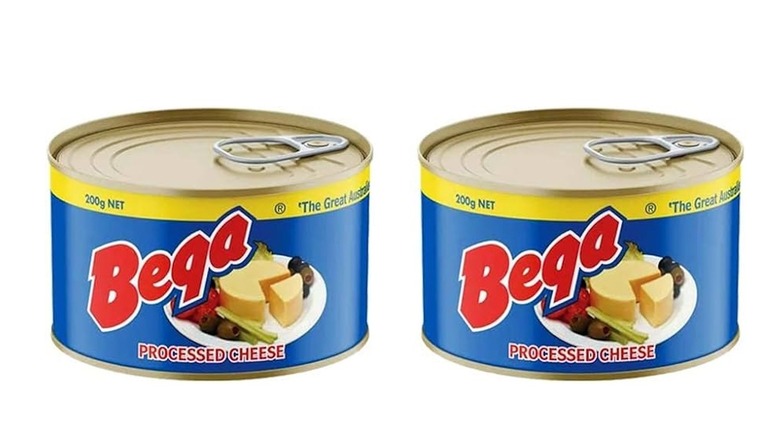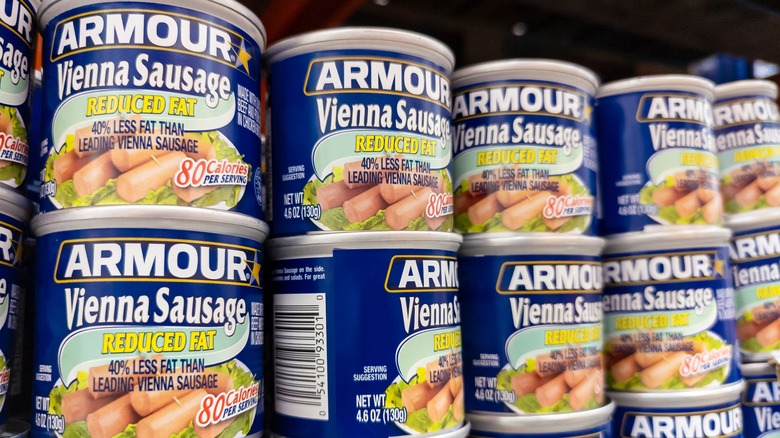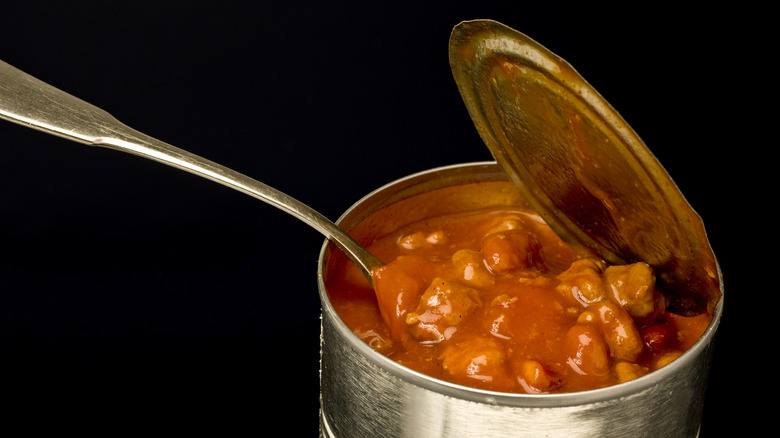Canned Foods You Should Avoid At All Costs
We may receive a commission on purchases made from links.
Can you imagine a world without canned foods? Neither can we. Canned items have been around since the 1800s and they've come a long way since. Nowadays, they have their own aisle at the grocery store and likely a section in your home pantry. When stocking up, you can find a vast array of canned offerings, from produce to pasta and everything in between. However, not all canned goods were created equal, and the world may be better off without specific varieties.
You see, the canning process can drastically alter the taste and texture of foods — and not always in a good way. Luckily, you don't need to gamble on unknown canned goods because we're here to help. We pulled from personal experience and reviewed online comments across social media, forums, and product review sites to determine which products are better left on store shelves. Mind you, we've already written about the healthiest and unhealthiest canned foods, so in this article, we focused purely on the sensory elements. Think taste, texture, smell, and appearance.
In our research, we discovered that certain canned goods are far removed from their fresh counterparts. Some have an appalling taste and questionable consistency while others are unidentifiable based on looks alone. So whether you're a home cook with a well-stocked kitchen or a doomsday prepper diversifying your supply, we encourage you to keep reading. We'll share the canned foods frequently given negative feedback, detailing exactly why you should spare your tastebuds with each.
Chicken
Canned chicken doesn't sound like an outlandish idea. However, you may want to think twice before buying canned poultry because it isn't nearly as versatile as the fresh stuff. The flavor and texture of chicken relies heavily on how it's cooked. Since canned chicken is already prepared, you don't have the option to marinate, barbecue, or bake it.
Also, after sitting in the can, the gelatin begins to separate, which can look unsightly. This is especially true for whole canned chicken. Yes, you heard us right. Whole canned chicken is actually a thing and we don't recommend trying it.
Whole canned chicken is just as it sounds; an entire cooked chicken (bones, skin, and all) squashed into a can. It comes in its own broth, and there can be a lot of it, resulting in extremely soggy meat. We're cringing at the thought of eating it, but if one thing is for certain, this canned food definitely puts the gag in gag gift.
Leafy green vegetables
Trying to get more veggies in your diet? Leafy greens are a great versatile way to get them in, and if you can't eat yours fresh, cans are a great way to go. But bear in mind that certain products aren't quite as tasty in canned form, particularly leafy green vegetables. This includes spinach, kale, collard greens, turnip greens, and more.
These leafy green vegetables are typically canned with water. Over time, much of their flavor and vibrant green color leeches into this water, along with some of those precious nutrients. Unfortunately, most of the liquid is drained before consumption.
Canned vegetables are also cooked inside the can after being sealed. Some are even cooked an additional time prior to canning. Since the veggies, water, and tin can are all heated together, the greens take on a metallic taste. In summary, you have got less fresh flavor and more metal, which is not exactly ideal for produce. If you need long-lasting greens, we would opt for frozen over canned.
Spam
Spam isn't just something to avoid in your inbox; you should probably avoid the canned version, as well. Since this product is associated with past generations, you might be wondering who still eats it anyway. However, you'd be surprised to learn that Spam is a beloved food in certain locations, including the Philippines, Korea, and Hawaii.
On the U.S. mainland, Spam has received a significant amount of disdain. And those that didn't grow up eating it, don't tend to enjoy its flavor. This processed meat tastes similar to ham, but with the texture of bologna, although mushier (especially if eaten straight from the can).
We do have to hand it to the Hormel company, the producers of Spam, for its clever marketing tactics. Spam was created during the Great Depression as a way to offload unwanted cuts of pork. Advertisements initially targeted housewives, promising an economical way to cut down cooking time. Later, it became a staple military ration, which explains why it's still popular in locations where U.S. forces were previously stationed. However, the days of '50s housewives and militarily rationed Spam are behind us. So, unless you have a particular pension for canned meat, we would skip the stuff.
Pre-cooked pasta
If you come from an Italian family, you would likely cringe at the thought of canned pre-cooked pasta. But truthfully, even the average American should rethink purchasing a can. Canned pasta just does not compare to the real thing.
For starters, canned pasta is often overcooked, leaving you with super soft noodles that break way too easily with the touch of a fork. Meanwhile, let's just say the sauce in canned pasta is a far cry from fresh tomato sauce. And since the sauce is sitting in aluminum, it picks up that metallic taste.
Italian chef and TikToker Vincenzo's Plate proves our point in a dramatic video clip. He samples Heinz canned spaghetti with meatballs, opening the tin to give us a peek inside. The visual is less than appealing as the sauce has hardened to form an orange gelatin layer. The chef then recoils from the "factory food" scent wafting from the can. After biting into the pasta, Vicenzo lets out a few Italian expressions that lead us to believe the contents are inedible.
Tamales
Do you have a food from childhood that, when revisited as an adult, did not quite hold up to expectations? For many, that food is canned tamales. On Reddit, one user reminisces, "They taste like childhood nostalgia, but I just can't let myself eat them now," while another laments, "I was forced to eat them as a kid. I would never eat one now, they taste absolutely nothing like a proper tamale."
Even if you've never heard of this canned food, it sounds like an abomination. One of the best aspects of Mexican food is its hot, homemade appeal, which completely evaporates the second you seal tamales in a can. Yet, Hormel (the same company behind Spam) sells canned tamales in beef, Hot'n'Spicy Beef, and chicken varieties.
They definitely have a weird soggy texture, and much more dough than filling (along with a strange taste). So if it is tasty tamales you are after, avoid the canned ones at all costs.
Haggis
Haggis is not a dish you hear about too often — unless you are from Scotland. It is often compared to animal products like black pudding (aka blood pudding), which already gets finicky eaters shying away. But before you write this food off, you should understand what haggis is all about.
This Scottish national dish is made of a whole host of sheep organs including heart, liver, lungs, and stomach. It is rounded out with grains, onions, and spices and traditionally encased inside the animal's stomach lining before being boiled and served. If you do not have the time or resources for all this, you can buy a canned version, but we do not recommend it.
For starters, most Americans can't stomach the idea of haggis (pun intended). And when you crack open the can, the dish's appearance does not do it any favors. It looks like dark ground meat, but grainier. When you dump out the contents, do not expect them to retain the shape of the can. Given the slightest pressure, haggis will crumble into a pile on your plate. If you do enjoy animal innards, no judgment here. But we recommend getting a fresh version from the store or specialty butcher for an enhanced appearance and flavor.
Corned beef
Have you ever wondered what the "corned" in corned beef is all about? Well, the corned part is not referring to corn at all, but rather a salted and cured cut of meat. The canned variety of corned beef was originally meant as military rations, not everyday fare, and it is pretty obvious by the taste.
Its flavor is reminiscent of a hot dog, but saltier. Meanwhile, it has a finer texture than standard ground meat, almost resembling cat food (being tinned doesn't help this image). If you have never seen it before, its pinkish hue leaves you curious whether it is actually raw or cooked. We assure you, it is indeed cooked and is one of those foods that can be eaten straight from the can (although we would not recommend it).
At this point, you are probably thinking, "But corned beef hash is delicious!" This is entirely true, and if making this dish, we recommend buying salt-cured beef from your local butcher. The canned version gives many people the ick, which is proven by a Tasting Table survey. When asked what foods they never buy canned, 62% of respondents replied canned meat.
Fruit in syrup
Canned fruits are a godsend. They allow us to eat nature's candy all year long and give us access to otherwise unattainable produce like mangoes, leeches, or pineapples. With that said, not all canned fruits are worth buying, particularly those with syrup.
Canned fruits can be packed in light or heavy syrup. So what exactly is this syrup? It is a viscous liquid sweetened with ingredients like sugar, corn syrup, and high fructose corn syrup — sometimes all three. It is basically a sugar bomb that overwhelms the pallet with an artificial sweetness. Sadly, pears, peaches, and fruit cocktail frequently come in this syrup.
Meanwhile, maraschino cherries take it to the next level. They are packed in syrup, so they also fall in this category, but they go through much more processing than other canned fruits. They are soaked in a brine solution that bleaches them before they are dyed a bright red. The end result? A funky-tasting fire engine red cherry that barely resembles the fruit it once was.
Bananas
Regardless of whether canned bananas are packed with syrup or not, they should be avoided. Bananas are already such a finicky fruit. They have a short window in which they present an ideal consistency. If you catch them too early, they will be tough with a chalky taste. And if you miss their peak ripeness, they will quickly turn on you, resulting in a mushy brown mess. So with this in mind, we did not have high hopes for canned bananas, and, unfortunately, online forums confirmed our suspicions.
This Reddit thread focused on Aroy-D Bananas in Syrup, and the visual alone left a lot to be desired. While the image on the can displays normal-looking peeled bananas, the contents of the can are unrecognizable. They resemble sausages more than they do bananas. Despite this, one brave Reddit user went in for the kill and described, "They tasted like stale bananas. They pretty much just crumbled in my mouth."
Meanwhile, at the time of writing this article, the same product received a sole review on Amazon. It was given a 1-star rating with the consumer noting, "Banana is very-very hard. Very dissatisfied." It seems the texture is unreliable and the only constant is customer dissatisfaction.
Processed cheese
Appearance is a big part of the dining experience and what you see when you first open that can matters. If you get the ick straight from the jump, it's going to be difficult to enjoy your food. Unfortunately, that's exactly what you experience with most canned processed cheeses.
Bega is just one brand that proves us right. This Australian cheese is touted as "very soft with a mild-tasting cheddar flavor." However, many customer reviews say otherwise. On Amazon, one reviewer urged consumers to steer clear of this product, stating it was "Bland. Do not buy. I am creative, but this cheese was horrible, even for a pantry emergency stock."
Reviewers also mentioned it was pungent and not so spreadable. So, if you're hoping to reignite childhood memories of Handi-Snacks cheese spread over Ritz crackers, look elsewhere. People are always trying to reinvent the wheel. Ultimately, some food products are simply not meant to be shelf stable, and that includes most cheeses. Unless you find yourself in a Doomsday situation, we'd stick to fresh cheeses that provide a much more authentic flavor and consistency.
Sausage
Cheap sausages are already known for their processed flavor, and canned varieties like Vienna sausage take it to the next level. These sausages are made by grinding up various cuts of meat into a purée, seasoning it, and covering it in an inedible casing. It's then cooked, the casing is removed, and it's chopped into small sausages before being canned with broth.
When sampling a Vienna sausage, don't expect the flavor of sausages or hot dogs. They're not nearly as meaty and have a completely different texture. One Reddit user explains that they taste like "Cold, soft hot dogs. They almost melt in your mouth, and not in a good way. It's like "meaty" Jello."
We'd leave this product firmly on the store shelf. But if you have a leftover can you don't want to waste, get creative. Mix it with mac' n' cheese, baked beans, or pigs in a blanket to mask the sausage's unappealing qualities.
Chili
We've already referenced a Tasting Table survey in which participants were asked which foods they never buy canned. The top response was canned meat, but the second? Chili. This answer surprised us seeing how canned chili isn't all that bad. We even taste-tested and ranked the best canned chilis on the market. However, we get where people are coming from.
Buying canned chili feels like cheating and store-bought options don't come close to homemade versions. Furthermore, chili is one of those dishes that tastes better after it's sat for a few days, so you'd think canned versions would be superior. But they simply don't build flavor in a can.
We can't quite pinpoint exactly what makes homemade chili so delicious. Perhaps it's the fresh ingredients, a unique blend of spices, or lack of preservatives. Or maybe it's that little dose of passion that home chefs add. But if one thing is for sure, canned chili lacks that rich, super satisfying quality.
Brown bread
Bread in a can? Yes, it's a thing and we're just as surprised as you are. Apparently, B&M's Brown Bread is a New England tradition and quite well-known in the area. In fact, canned brown bread has a long history that dates back nearly a century. However, we can't help but wonder if this regional favorite is more about nostalgia than flavor. On Reddit, those who didn't grow up eating canned brown bread describe it as "an acquired taste," which may simply be a euphemism for unappetizing.
However, perhaps we're being harsh and it's all a matter of perspective. If you approach this canned good as regular bread, you'll be sorely disappointed. This product is more similar to a dense cake than it is bread so it's best to consider it as such. But again, when we say "cake," we'd lower your expectations. We're not talking fresh pastries here. And you can forget about throwing it in the microwave; it'll take on a rubbery texture. The best approach to canned brown bread is slicing it into rounds and toasting it with some butter.

